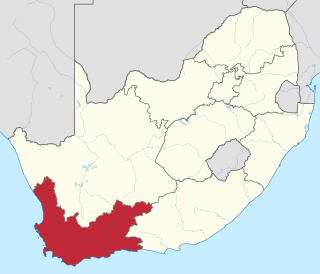
The Western Cape is a province of South Africa, situated on the south-western coast of the country. It is the fourth largest of the nine provinces with an area of 129,449 square kilometres (49,981 sq mi), and the third most populous, with an estimated 7 million inhabitants in 2020. About two-thirds of these inhabitants live in the metropolitan area of Cape Town, which is also the provincial capital. The Western Cape was created in 1994 from part of the former Cape Province. The two largest cities are Cape Town and George.

Limonium is a genus of 120 flowering plant species. Members are also known as sea-lavender, statice, caspia or marsh-rosemary. Despite their common names, species are not related to the lavenders or to rosemary. They are instead in Plumbaginaceae, the plumbago or leadwort family. The generic name is from the Latin līmōnion, used by Pliny for a wild plant and is ultimately derived from the Ancient Greek leimon.

Solanum pseudocapsicum is a nightshade species with mildly poisonous fruit. It is commonly known as the Jerusalem cherry, Madeira winter cherry, or, ambiguously, "winter cherry". These perennials can be grown decoratively as house plants, but in some areas of South Africa, India, Australia and New Zealand it is regarded as a weed.

Ehrharta is a genus of plants in the grass family.
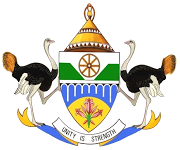
Xhariep is one of the 5 districts of Free State province of South Africa. The seat of Xhariep is Trompsburg. The largest language group is Sotho who make up 45.3% of the total population of 146,259. The district code is DC16.

Frances Baard is one of the 5 districts of Northern Cape province of South Africa. The seat of Frances Baard is Kimberley. The majority of its 324 814 people speak Setswana. The district code is DC9.

Namakwa is one of the 5 districts of the Northern Cape province of South Africa. The seat of Namakwa is Springbok and the region is also known as Little Namaqualand. The majority of its 108,118 people speak Afrikaans. The district code is DC6.

Amathole is one of the 7 districts of Eastern Cape province of South Africa. The seat of Amathole is East London. Over 90% of its 892,637 people speak Xhosa. The district code is DC12. "Amathole" means calves, the name of the mountain range and forest which forms the northern boundary of the district.
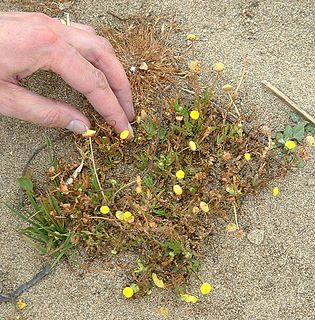
Cotula is a genus of flowering plant in the sunflower family. It includes plants known generally as water buttons or buttonweeds.
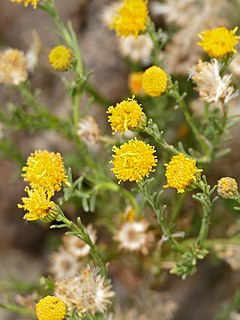
Pentzia is a genus of African plants in the chamomile tribe within the sunflower family. One species (P. incana) is naturalized in Australia and in the southwestern United States.
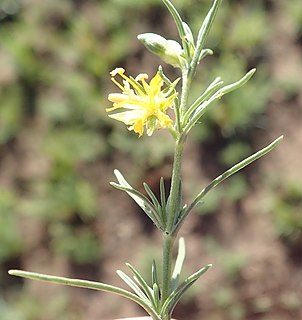
Vahlia is a genus of herbs and subshrubs that grow in Africa and the Indian subcontinent. There are at least five species.

Leucospermum cordifolium is an upright, evergreen shrub of up to 1½ m (5 ft) high from the Proteaceae. The flower heads are globe-shape with a flattened top, 10–12 cm (3.9–4.7 in) in diameter, and are carried individually or with two or three together mostly at a right angle to its branch. The perianth is 3–3½ cm long, yellow, orange or crimson in color. From each flower emerges a 4½–6 cm (1.8–2.4 in) long style sticking out horizontally but curving upwards near the obliquely, shell-shaped, thicker pollen presenter. This gives each head the appearance of a pincushion. Its common name is ornamental pincushion in English and bobbejaanklou in Afrikaans. It flowers between the middle of July and the end of November. It naturally occurs near the south coast of the Western Cape province of South Africa. Varieties and hybrids of this species are used as cut flower and garden plant.
Amellus is a genus of flowering plants in the family, Asteraceae described as a genus by Linnaeus in 1759.
Dichrocephala is a genus of flowering plants in the sunflower family, native to tropical Africa and southern Asia.
Microglossa is a genus of Asian and African flowering plants in the aster tribe within the sunflower family.

Paranomus is a genus of 18 species of flowering plants, commonly known as "sceptres", in the protea family. It is endemic to the Cape Floristic Region of South Africa.
Mairia is a genus of African flowering plants in the aster tribe within the sunflower family.

Leucospermum tottum is an upright, evergreen shrub of up to 1½ m high and 2 m (6 ft) in diameter from the Proteaceae. The oblong, mostly entire leaves with a bony tip are somewhat spreading and distant from each other, and so exposing the stem. It is called elegant pincushion or ribbon pincushion in English, and oranje-rooi speldekussing or vuurhoutjies in Afrikaans. Flowers can be found between September and January. The species naturally occurs in the Western Cape province of South Africa. Two different varieties are distinguished, which are genetically very close, but differ in the color, orientation and tube-length of the flowers, the volume and sugar content of the nectar. This is probably an adaptation to different pollinators.














